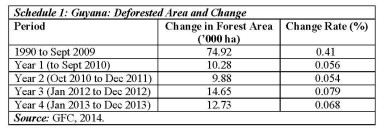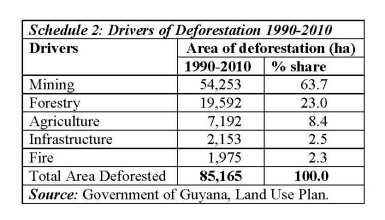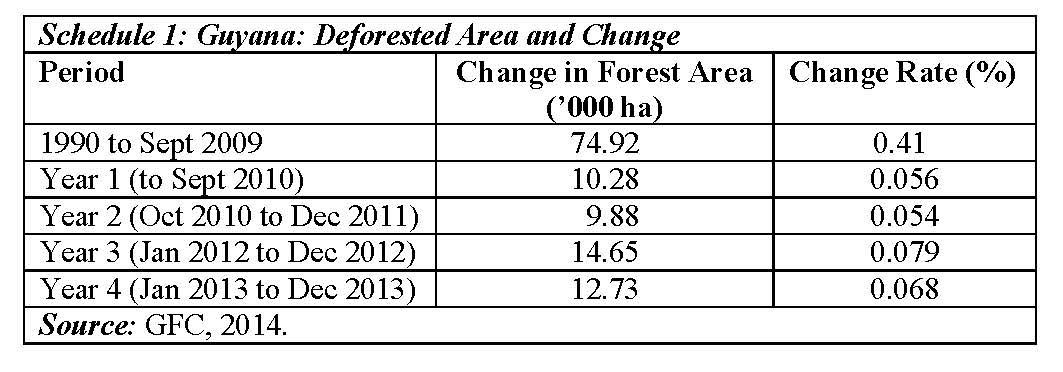The MDGs and the Forest agenda
Last week’s column addressed the burning question: “Is the global community driving the domestic agenda for Guyana’s forests?” My response to that was in the affirmative. In the column, I went on to recount information provided in earlier columns in support of this view. That information stressed the policy influence of the Earth Summit, held in Rio  de Janeiro, Brazil, in 1992. As I indicated there, this influence led directly to the pivotal roles played by the United Nations Food and Agriculture Organisation (FAO); the United Nations Convention on Bio-diversity (UNCBD); the Low-Carbon Development Strategy (LCDS); and, the United Nations Convention to Combat Desertification (UNCCD), in framing the “Vision, Objectives and Goals of Guyana’s forest and land use policies”.
de Janeiro, Brazil, in 1992. As I indicated there, this influence led directly to the pivotal roles played by the United Nations Food and Agriculture Organisation (FAO); the United Nations Convention on Bio-diversity (UNCBD); the Low-Carbon Development Strategy (LCDS); and, the United Nations Convention to Combat Desertification (UNCCD), in framing the “Vision, Objectives and Goals of Guyana’s forest and land use policies”.
To complete the presentation, today’s column urges readers to recognize that those global efforts were framed under the general rubric of the Millennium Development Goals (MDGs), 2000-2015. These MDGs expressed the ambitious global development framework, under which development policies and resources transfers from rich to poor countries were expected to place, in the drive to reduce poverty and hunger, and to raise universal health, education, and other basic services in poor countries.
Sustainable Development Goals
Ambitious as the MDGs were, however, as they came to an end in 2015, they have been morphed into the far more ambitious seventeen (17) Goals, set at the 2015 United Nations Summit aimed at achieving global Sustainable Development (SD) over the period 2015-2030. Of significance for our present purposes, the 17 SD Goals have identified in Goal 15 the specific policy aims and targets for global forests.
Thus, Goal 15 aims to protect, restore, and promote sustainable use of terrestrial ecosystems through “the sustainable management of forests; combatting desertification; and, halting and reversing land degradation and biodiversity loss”. Of great relevance also, Goal 13 expresses the need for “urgent action to combat climate change and its [adverse] effects”. Further, Goal 14 speaks of conserving, and sustainably utilizing the oceans, seas, and marine resources for development!
When carefully examined, these SD Goals seek to mainstream forests and their related concerns, not only into the ambition and endeavours of UN-sponsored global polices and activities, but also into the regional, and, most importantly, national developmental agendas as well.
If these Goals and Targets are applied to Guyana’s forests, then we observe that, the primary concern, which arises is the need to conserve Guyana’s native forest stocks, and to avoid deforestation, particularly that induced by human activities. Undoubtedly, the preeminent goal of the global forest agenda is to prevent forest and bio-diversity loss on the Planet. In this regard there is a determination among global players to keep Guyana’s high forest cover as intact as possible, at the lowest possible cost to the global community. Guyana however, is extremely valuable to the world as “a high forest ̶ low deforestation (HFLD)” country. Its interests in seeking to preserve this status should be guided, I believe, by the highest possible returns its citizens can derive from this. In the next Section, I address deforestation in Guyana.
Deforestation
There is such wide variation in the estimates of the size of Guyana’s forest cover, I had earlier indicated that for purposes of these columns, I would rely on the numbers provided by the FAO. Similarly, I observed there is equally striking variation in the classification of its forests. Added to this, as matters stand, there is considerable variation as well in existing estimates of deforestation in recent decades. The most conservative of those estimates come from the FAO, which indicates zero to negligible deforestation!
Taking this into account, the estimates I present below, while reported on the FAO website, derive from the Guyana Forestry Commission (GFC), 2014, and Poyry Consultants under the LCDS Agreement. These are presented in Schedule 1, which reveal that, over the 23 year period, the absolute forest conversion from forest to non-forest in Guyana has been about 123,000 hectares. This is equivalent to an annual rate of decline of about 0.41 percent for the 19.75 year period (1990-Sept 2009); 0.56 percent for the year (Sept 2009 – Sept 2010); 0.054 percent for the 1.25 year period (Oct 2010 to Dec 2011); and, 0.079 percent and 0.068 percent for the years 2012 and 2013 respectively.

Deforestation is measured in Guyana using remote sensory imaging by satellite and “ground-truthing” exercises to confirm the satellite information.
It should be observed though, while the reported data vary in their identification of deforestation, all the different reports I have seen list “Mining”, as the leading driver; even though there is significant disagreement over its pace.
Schedule 2 presents the data on drivers of deforestation, cited in Guyana’s Land Use Plan. It assigns the drivers over two decades, 1990 to 2010. These are in descending order of significance, Mining (63.7 percent); Forestry (23.0 percent); Agriculture (8.4 percent); Infrastructure works (2.5 percent); and, Forest fires (2.3 percent). These drivers clearly indicate the impacts of human activities on the forests (mining, settlements, agriculture), as well as those induced by both nature and human activities (forest fires).

Next week’s column will address the impact of this deforestation on the carbon stock of Guyana’s forests.










